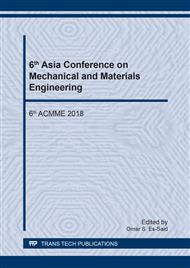p.50
p.55
p.61
p.66
p.73
p.79
p.89
p.95
p.100
Effect of Cooling Speed on the Microstructure and Mechanical Properties of Sn-0.7Cu-0.05Ni Solder Alloy
Abstract:
To study the effect of cooling speed on the microstructure and mechanical properties of Sn-0.7Cu-0.05Ni solder alloy, molten alloys were cooled at two different rates, using water-cooling and mold-cooling. The mechanical properties of the obtained alloys were analyzed with a universal testing machine (UTM) and by Vickers microhardness testing (HV). The microstructures were characterized using an optical microscope (OM) and energy dispersive X-ray spectroscopy (EDX).The melting point was ascertained by differential scanning calorimetry (DSC). The cooling rate of the water-cooled system (0.28 o C/s) was faster than the cooling rate of the mold-cooled system (0.05 °C/s). The grain size of the alloy produced by the faster cooling rate was finer than that of the alloy obtained from the slower cooling rate. This finer grain size gave the alloy superior ultimate tensile strength (UTS) and hardness but inferior ductility (%EL). The microstructure of both Sn-0.7Cu-0.05Ni solder alloys exhibited three phases of β-Sn, Cu6Sn5 and (Cu,Ni)6Sn5 intermetallic compounds. The melting point and undercooling of the solder alloys was 233.8 °C and 35.7 °C, respectively.
Info:
Periodical:
Pages:
73-78
Citation:
Online since:
October 2018
Authors:
Price:
Сopyright:
© 2018 Trans Tech Publications Ltd. All Rights Reserved
Share:
Citation:


